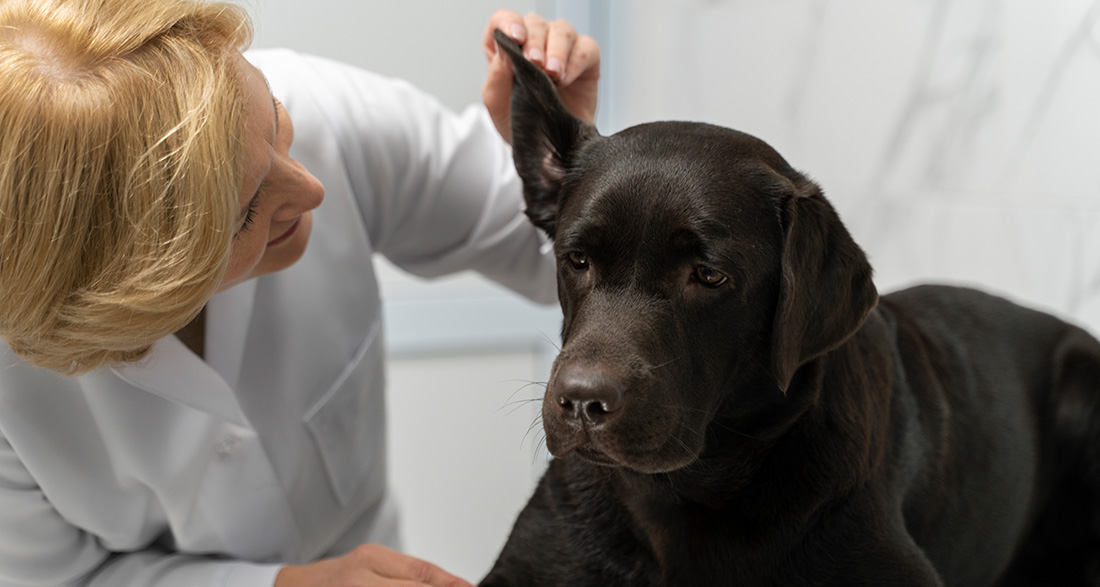Ear infections are not uncommon in dogs but should be taken seriously. Learn to recognize the symptoms and how you can help your dog.
Symptoms: How to Recognize an Ear Infection in Dogs
An inflammation of your dog’s ear is not uncommon but should be taken seriously. Often, it is an inflammation of the external ear canal (otitis externa), also known as swimmer’s ear. However, the middle ear (otitis media) or inner ear (otitis interna) can also become inflamed.
You can usually recognize problems with your dog’s ear quite well. To do so, pay attention to the following symptoms:
- Increased, vigorous head shaking
- Tilting of the head
- Constant scratching at the ear
- Rubbing the face or ear on the ground
- Redness, swelling, or scabs on the inner side of the ears
- Ears feel warm
- Sensitivity to touch on the head
- Loss of balance
- Brownish, unpleasant-smelling discharge on the inner side of the ears
If your dog shows one or more of these symptoms, you should consult a veterinarian, as an ear infection is always a matter for professionals.

Causes: How Does Your Dog Get an Ear Infection?
Before your four-legged friend can be treated, the veterinarian will first determine the cause of the ear infection. Only then can help be provided. Common reasons include a fungal infection, ear mites, foreign objects, or allergies. However, anatomical factors can also cause an ear infection.
Anatomical Factors:
Dogs with floppy ears, narrow ear canals, or long fur often experience ear infections more frequently. Due to the strong hair growth and the hanging ear, the inner ear is less ventilated, and earwax is less effectively removed. Consequently, a warm and humid environment is created in the ears, providing an ideal habitat for bacteria. An ear infection or ear infection in dogs is then not far away.
Yeast Infections:
Malassezia are yeast fungi that are normal in small numbers on your dog’s skin surface. They are often found in the external ear canal or under the tail. However, excessive growth of these fungi can lead to an ear infection (Malassezia otitis). Dogs with floppy ears that enjoy bathing are often affected. If residual moisture remains in the ear, a warm and humid environment is created, favoring the multiplication of Malassezia.
Ear Mites:
An infection with ear mites can also lead to an ear infection in your dog. The infection can cause the ear canal to thicken and narrow, making it less ventilated and providing a favorable environment for fungi and bacteria.
Allergies:
If your dog suffers from allergies, a red or even inflamed ear is a common symptom. Especially in the case of environmental allergies to pollen or dust mites, as well as food intolerances, the ears are quickly irritated. In treatment, it is essential to address the allergy promptly to prevent chronic ear infections.
Foreign Objects:
If coarse dirt or awns become lodged in your dog’s ears, this can also promote inflammation. In the case of awns, you should be particularly careful and have a professional take a look. These are small, often bristly plant particles that migrate deeper into your dog’s ear canal and settle there.

Treatment: What Helps Against an Ear Infection in Dogs?
After the veterinarian has thoroughly examined your pet and determined the cause, the appropriate treatment will be initiated. Often, your four-legged friend can be helped quickly, while in other cases, therapy may be more prolonged.
Sometimes, a simple ear flush that cleans your dog’s ear canal or manual removal of a foreign object is sufficient. Depending on the cause, antibiotic and anti-inflammatory ointments, tablets, or drops against bacteria or fungi may also be prescribed. If your dog is in pain or itching, medication can help in these cases as well. Surgery is usually only necessary for chronic ear infections, severely narrowed ear canals, or tumors in the ear.
If a food allergy or intolerance is the cause of your dog’s ear infection, switching to a different food with more tolerable ingredients can help. Relief may take a few weeks, but it ensures enjoyment during meals! Often, dogs are allergic to chicken, beef, and/or certain grains. If you’re still looking for a healthy and delicious hypoallergenic food, take a look at our hypoallergenic food varieties!
How to Prevent Ear Infections in Your Dog
You should refrain from using home remedies or attempting to treat your dog’s ear infection on your own. If the infection is not treated properly and promptly, it can worsen and become chronic. In the worst case, the ear infection can lead to hearing impairment, balance problems, or damage to the facial nerve.
Regular and thorough ear care for your dog is therefore essential if you want to prevent an ear infection as effectively as possible. This includes:
- Regular cleaning of your dog’s external ear canal with a damp cloth. You can use our CARE Ear Cleaner for support. It cleans, protects, and cares for your dog’s ears based on purely natural ingredients and helps with irritations caused by yeast fungi and parasites. Never clean the ear with a cotton swab, as there is a risk of pushing possible foreign objects or deposits further into the ear canal.
- After consulting your veterinarian, you can also use a mild ear flush.
- If your dog has longer hair that tends to grow into the ear, trim or cut it slightly shorter. This ensures that the ear continues to be well-ventilated, and no parasites or bacteria can accumulate.
- In the case of allergy-related ear infections, you should avoid contact with the allergens as much as possible.


